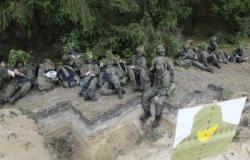Loading player
On Sunday the International Organization for Migration (IOM), which is linked to the United Nations, released new updates relating to the landslide which hit Kaokalam, Yambali and Tulipana, three villages in the Enga region, in the state oceanic Papua New Guinea. According to the IOM, the landslide caused the death of at least 670 people (until yesterday the estimate was around one hundred).
UN official Serhan Aktoprak told the news agency Associated Press that the estimate derives from the higher number of houses left buried than initially estimated: until yesterday it was assumed that there were 60, but after the first rescue teams reached Yambali the estimate is at least 150. Another 250 houses were damaged from the landslide, displacing at least 1,250 people: to provide them with medical assistance, mobile aid points were built with difficulty in the area.
(Benjamin Sipa/International Organization for Migration via AP)
The first rescue teams reached the village with difficulty because the landslide blocked the road leading to Yambali, slowing down operations more than expected. The humanitarian organization CARE Australia said that Yambali can currently only be reached by helicopter. The searches were carried out by hand for hours and only on Sunday it was possible to obtain a mechanical shovel thanks to the donation of a local builder. In many parts of the landslide, bodies are no longer being searched for, buried under a few meters of debris.
(EPA/Ninga Role via Ansa)
Rescuers are proceeding slowly also due to security problems: for months in the Enga region there have been very violent clashes between the numerous tribal groups that populate the area, where episodes of violence linked to thefts and territorial disputes occur regularly. In February, for example, 54 people were killed as part of a clash between two factions: the first made up of the Saa Walep and Ambulyn tribes, the other by the Kaekin, Palinau and Sikin.
– Read also: In Papua New Guinea, tribal groups are a serious problem
The convoys that left on Saturday to transport food, water and other essential goods to the village necessarily have to travel along a secondary road that passes near the village of Tambitanis, where a harsh clash between rival tribal groups has been ongoing for months. The IOM has warned that convoys may be targeted by these groups to loot and steal goods.
Papua New Guinea was a colony administered partly by the German Empire and partly by the British Empire. It has become independent since 1975, when it stopped being controlled by Australia, and is part of the Commonwealth, the group of countries that were part of the British Empire and which after independence have maintained more or less formal ties with the English crown .
With almost 10 million inhabitants, it is one of the most populous countries in the South Pacific and is also one of those with the most varied population: its inhabitants belong to different ethnic groups, mainly Melanesian and Papuan, they are almost all Christians and the official language for trade is English.
However, the rapid growth of the population seen especially between the 1960s and the 1980s brought about numerous problems, which often still exist today: access to basic services, such as healthcare or education, is frequently not guaranteed, and unemployment and underemployment have increased poverty, also increasing tensions between various ethnic groups and crime, especially in urban areas.






